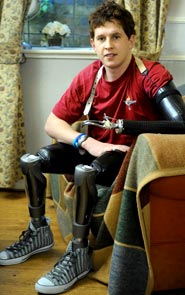 Triple amputee Cpl Tom Neathway from Worcester who lost an arm and both legs while serving with The Parachute Regiment in Afganistan |
MORE than 100 British soldiers have suffered amputations and other debilitating injuries in the past year in Afghanistan, according to previously suppressed Ministry of Defence (MoD) figures that reveal the true toll of the Taliban’s roadside bombing campaign.
The number of troops losing limbs or eyes, suffering serious burns or permanent brain damage has increased dramatically since August 2007 when the Taliban intensified their efforts.
During the past 18 months, 37 of the 71 British troops killed are known to have been the victims of roadside bombs or mines, but the number of troops disabled in the attacks has never been fully disclosed.
Figures obtained by The Sunday Times from medical sources show that 37 soldiers suffered “life-changing injuries” between April 2006, when they first deployed to southern Afghanistan, and the end of that year.
There were 55 such injuries during the whole of 2007. Last year the figures more than doubled to 114 and there have been 12 cases this year.
Campaigners claim the MoD is deliberately keeping the human cost of the war out of the public eye. They say the government must fund long-term care for maimed or mentally disabled soldiers instead of relying on charities such as Help for Heroes and the Royal British Legion.
The MoD has bought better armoured vehicles in an attempt to counter the Taliban offensive, which has seen a fourfold increase in improvised explosive devices (IEDs).
However, with the insurgents using such large amounts of explosives there is a limit on the protection afforded even by new Mastiff armoured vehicles.
There have been cases of soldiers in Mastiffs who were protected from a blast but who lost their legs below the knee as a result of the shock wave inside the vehicle.
Commanders have also demanded more helicopters so that troops do not have to move by road. Such is the scarcity that last week a British operation against the drug barons financing the Taliban had to use aircraft provided by the US marines.
This weekend the MoD admitted that 23 soldiers underwent amputations between December 2007 and November 2008, but said it was unable to provide a breakdown of other serious injuries.
Among the victims was Lance-Corporal Tom Neathway, a 25-year-old paratrooper from Worcester, who lost both his legs and an arm following a Taliban explosion last July in Kajaki, northern Helmand.
“The Taliban are not stupid; they know what they are doing,” he said. “We had swept that whole area for IEDs previously. They had seen a loophole where a sniper could take aim from and set the device in that position.”
The Taliban had seen British troops using metal detectors to find bombs and switched to using non-metallic components.
“The ambulance driver who transported me was hit by another device on his way back and died,” Neathway said. During his stay at Selly Oak hospital in Birmingham, Neathway had to be resuscitated three times. He was later moved to Headley Court, a military rehabilitation centre in Surrey.
Tony Garland, a defence consultant, spent several weeks at Selly Oak hospital when his son was wounded and was shocked at the number of disabled soldiers.
“I saw maimed soldiers, some who had lost limbs and some with brain damage. They get first-class medical treatment while they are in the army but there is no long-term care for them when they leave,” he said.
Garland, 66, from Newbury, Berkshire, is campaigning to force the government to fund long-term care rather than rely on charities. “Our maimed and injured service personnel are the hidden face of an unwinnable military conflict and one the government is reluctant to reveal,” he said.
Garland’s concerns about long-term care are shared by the parents of Anthony Makin, 22, a bombardier in 29 Commando regiment, who lost his right foot when his patrol vehicle hit an IED near Garmsir, south ern Helmand, in December 2006.
Makin’s mother Allison, a care worker from Newcastle upon Tyne, said: “We worry about what would occur if he comes out of the army. He laid down his life for the army. He should always be under their care after what he gave them.”
Kevan Jones, veterans minister, said: “Injured servicemen and women receive excellent healthcare while they are in the forces. I want to ensure this high standard of care continues for the rest of their lives.”
Additional reporting: Helen Brooks
MORE PROTECTION, MORE ATTACKS
October 2006: Marine Gary Wright is first British soldier killed in Afghanistan by roadside bomb as Taliban copy Iraqi insurgents’ tactics
May 2007: Ministry of Defence deploys Mastiff heavily armoured vehicles to replace more vulnerable Snatch Land Rovers
August 2007: Taliban escalate bombing campaign with roadside explosions accounting for 15 out of the next 18 British deaths in action
February 2008: Of the 71 soldiers who have died in Afghanistan in the past 18 months, 37 have been killed by improvised explosive devices. David Miliband, the foreign secretary, said the bombs had led to “strategic stalemate”
February 22, 2009
Michael Smith and Brendan Montague
Source: The Sunday Times